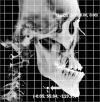Three-dimensional changes of the hyoid bone and airway volumes related to its relationship with horizontal anatomic planes after bimaxillary surgery in skeletal Class III patients
- PMID: 23311605
- PMCID: PMC8754032
- DOI: 10.2319/083112-700.1
Three-dimensional changes of the hyoid bone and airway volumes related to its relationship with horizontal anatomic planes after bimaxillary surgery in skeletal Class III patients
Abstract
Objective: To evaluate longitudinal changes of the hyoid bone position and pharyngeal airway space after bimaxillary surgery in mandibular prognathism patients.
Materials and methods: Cone-beam computed tomography scans were taken for 25 mandibular prognathism patients before surgery (T0), 2 months after surgery (T1), and 6 months after surgery (T2). The positional displacement of the hyoid bone was assessed using the coordinates at T0, T1, and T2. Additionally, the volume of each subject's pharyngeal airway was measured.
Results: The mean amount of posterior maxilla impaction was 3.76 ± 1.33 mm as the palatal plane rotated 2.04° ± 2.28° in a clockwise direction as a result of bimaxillary surgery. The hyoid bone moved backward (P < .05, P < .001) and downward (P > .05, P < .05) at 2 months and 6 months after surgery, while the total volume of the pharyngeal airway significantly decreased at the same time points (P < .001, P < .001). There was significant relationship between the changes of the hyoid bone position and airway volume at 2 months after surgery (P < .05). The change of the palatal plane angle was positively correlated to the decrease in the total airway volume (P < .001).
Conclusions: The null hypothesis was rejected. The hyoid bone moved inferoposteriorly, and the pharyngeal airway volume decreased for up to 6 months after bimaxillary surgery. The decrease in the pharyngeal airway volume was correlated to the changes in the palatal plane inclination and the positional change of the hyoid bone.
Figures


Similar articles
-
Three-dimensional changes in pharyngeal airway in skeletal class III patients undergoing orthognathic surgery.J Oral Maxillofac Surg. 2011 Nov;69(11):e401-8. doi: 10.1016/j.joms.2011.02.011. Epub 2011 May 14. J Oral Maxillofac Surg. 2011. PMID: 21571419
-
Head posture and pharyngeal airway volume changes after bimaxillary surgery for mandibular prognathism.J Craniomaxillofac Surg. 2014 Jul;42(5):531-5. doi: 10.1016/j.jcms.2013.07.022. Epub 2013 Aug 28. J Craniomaxillofac Surg. 2014. PMID: 24080139
-
Does upper premolar extraction affect the changes of pharyngeal airway volume after bimaxillary surgery in skeletal class III patients?J Oral Maxillofac Surg. 2014 Jan;72(1):165.e1-10. doi: 10.1016/j.joms.2013.09.020. J Oral Maxillofac Surg. 2014. PMID: 24331568
-
Cone beam computed tomography volumetric airway changes after orthognathic surgery: a systematic review.Int J Oral Maxillofac Surg. 2023 Jan;52(1):60-71. doi: 10.1016/j.ijom.2022.05.013. Epub 2022 Jul 1. Int J Oral Maxillofac Surg. 2023. PMID: 35788289
-
Comparison of Accuracy in Mandible-First and Maxilla-First Approaches in Bimaxillary Orthognathic Surgery: A Meta-Analysis.J Craniofac Surg. 2025 Jun 1;36(4):e459-e464. doi: 10.1097/SCS.0000000000011066. Epub 2025 Jan 10. J Craniofac Surg. 2025. PMID: 39791904
Cited by
-
Change of the upper airway after mandibular setback surgery in patients with mandibular prognathism and anterior open bite.Maxillofac Plast Reconstr Surg. 2019 Nov 26;41(1):51. doi: 10.1186/s40902-019-0230-4. eCollection 2019 Dec. Maxillofac Plast Reconstr Surg. 2019. PMID: 31824889 Free PMC article.
-
Silent Changes in Sleep Quality Following Mandibular Setback Surgery in Patients with Skeletal Class III Malocclusion: A Prospective Study.Sci Rep. 2019 Jul 5;9(1):9737. doi: 10.1038/s41598-019-46166-z. Sci Rep. 2019. PMID: 31278306 Free PMC article.
-
Automated 3D segmentation of the hyoid bone in CBCT using nnU-Net v2: a retrospective study on model performance and potential clinical utility.BMC Med Imaging. 2025 Jul 1;25(1):217. doi: 10.1186/s12880-025-01797-9. BMC Med Imaging. 2025. PMID: 40596942 Free PMC article.
-
Alterations in upper airway dimensions following bimaxillary and mandibular setback surgery in skeletal Class III patients: A cone-beam computed tomography study.J Dent Sci. 2025 Jul;20(3):1673-1680. doi: 10.1016/j.jds.2025.03.017. Epub 2025 Mar 27. J Dent Sci. 2025. PMID: 40654421 Free PMC article.
-
Effects of mandibular setback with or without maxillary advancement osteotomies on pharyngeal airways: An overview of systematic reviews.PLoS One. 2017 Oct 9;12(10):e0185951. doi: 10.1371/journal.pone.0185951. eCollection 2017. PLoS One. 2017. PMID: 29016682 Free PMC article. Review.
References
-
- Chen F, Terada K, Hua Y, Saito I. Effects of bimaxillary surgery and mandibular setback surgery on pharyngeal airway measurements in patients with Class III skeletal deformities. Am J Orthod Dentofacial Orthop. 2007;131:372–377. - PubMed
-
- Jakobsone G, Stenvik A, Sandvik L, Espeland L. Three-year follow-up of bimaxillary surgery to correct skeletal Class III malocclusion: stability and risk factors for relapse. Am J Orthod Dentofacial Orthop. 2011;139:80–89. - PubMed
-
- Kim YI, Sp JK. A study of upper airway dimensional change according to maxillary superior movement after orthognathic surgery. Korean J Orthod. 2008;38:121.
-
- Bailey LT, Proffit WR, White RP., Jr Trends in surgical treatment of Class III skeletal relationships. Int J Adult Orthod Orthognath Surg. 1995;10:108–118. - PubMed
-
- Hong JS, Park YH, Kim YJ, Hong SM, Oh KM. Three-dimensional changes in pharyngeal airway in skeletal Class III patients undergoing orthognathic surgery. J Oral Maxillofac Surg. 2011;69:e401–e408. - PubMed
Publication types
MeSH terms
LinkOut - more resources
Full Text Sources
Other Literature Sources

